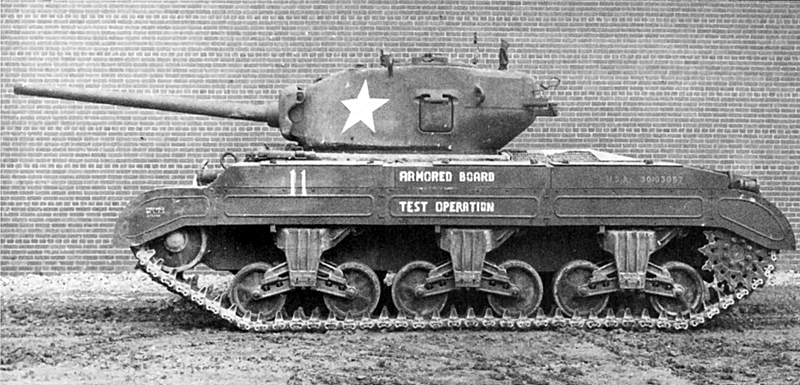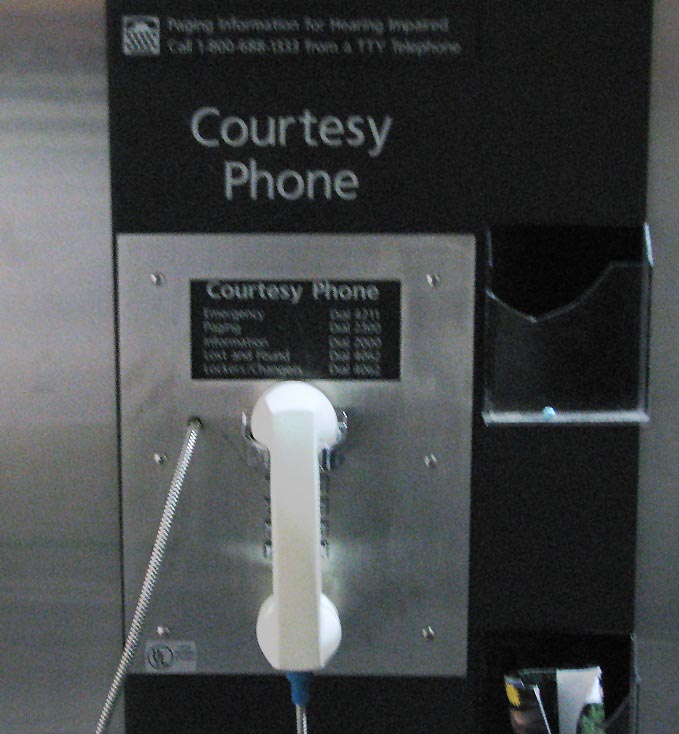|
Tank Phone
A tank phone (also called a tank telephone, grunt phone, tank-infantry phone, TIP, infantry tank telephone, ITT, or infantry phone) is a telephone mounted on the exterior of armoured vehicles to facilitate communication between people outside of the vehicle and those inside, whilst avoiding the tank crew becoming exposed to enemy fire. Purpose Communication between infantry and tanks may be possible via radio and other means. However, it is more efficient and reliable to provide a tank phone mounted typically on the rear of the tank in a small box that contains a standard telephone handset which infantrymen may use to speak directly to the tank commander. Infantrymen may thus direct the tank's fire, which they are better placed to do as the tank crew will typically have their vision impeded by being buttoned up within the tank. The typical method of doing this is using the present direction of the tank gun as a reference point and moving it onto the target from there using up/dow ... [...More Info...] [...Related Items...] OR: [Wikipedia] [Google] [Baidu] |
Telephone
A telephone, colloquially referred to as a phone, is a telecommunications device that enables two or more users to conduct a conversation when they are too far apart to be easily heard directly. A telephone converts sound, typically and most efficiently the human voice, into electronic signals that are transmitted via Electrical cable, cables and other communication channels to another telephone which reproduces the sound to the receiving user. The term is derived from and (, ''voice''), together meaning ''distant voice''. In 1876, Alexander Graham Bell was the first to be granted a United States patent for a device that produced clearly intelligible replication of the human voice at a second device. This instrument was further developed by many others, and became rapidly indispensable in business, government, and in households. The essential elements of a telephone are a microphone (''transmitter'') to speak into and an earphone (''receiver'') which reproduces the voice a ... [...More Info...] [...Related Items...] OR: [Wikipedia] [Google] [Baidu] |
M26 Pershing
The M26 Pershing is a heavy tank, later designated as a medium tank, formerly used by the United States Army. It was used in the last months of World War II during the Western Allied invasion of Germany, Invasion of Germany and extensively during the Korean War. The tank was named after General of the Armies John J. Pershing, who led the American Expeditionary Force in Europe during World War I. The M26 was intended as a replacement of the M4 Sherman, but a prolonged development period meant that only a small number saw combat in Europe. Based on the criteria of firepower, mobility, and protection, US historian R. P. Hunnicutt ranked the Pershing behind the German Tiger II heavy tank, but ahead of the Tiger I heavy and Panther tank, Panther medium tanks. It was withdrawn in 1951 in favor of its improved derivative, the M46 Patton, which had a more powerful and reliable engine and advanced suspension. The lineage of the M26 continued with the M47 Patton, and was reflected in the ... [...More Info...] [...Related Items...] OR: [Wikipedia] [Google] [Baidu] |
Tank Subassembly
A tank is an armoured fighting vehicle intended as a primary offensive weapon in front-line ground combat. Tank designs are a balance of heavy firepower, strong armour, and battlefield mobility provided by tracks and a powerful engine; their main armament is often mounted within a turret. They are a mainstay of modern 20th and 21st century ground forces and a key part of combined arms combat. Modern tanks are versatile mobile land weapons platforms whose main armament is a large-calibre tank gun mounted in a rotating gun turret, supplemented by machine guns or other ranged weapons such as anti-tank guided missiles or rocket launchers. They have heavy vehicle armour which provides protection for the crew, the vehicle's munition storage, fuel tank and propulsion systems. The use of tracks rather than wheels provides improved operational mobility which allows the tank to overcome rugged terrain and adverse conditions such as mud and ice/snow better than wheeled vehicles, and ... [...More Info...] [...Related Items...] OR: [Wikipedia] [Google] [Baidu] |
Armoured Fighting Vehicle Equipment
Armour (Commonwealth English) or armor (American English; see spelling differences) is a covering used to protect an object, individual, or vehicle from physical injury or damage, especially direct contact weapons or projectiles during combat, or from a potentially dangerous environment or activity (e.g. cycling, construction sites, etc.). Personal armour is used to protect soldiers and war animals. Vehicle armour is used on warships, armoured fighting vehicles, and some combat aircraft, mostly ground attack aircraft. A second use of the term ''armour'' describes armoured forces, armoured weapons, and their role in combat. After the development of armoured warfare, tanks and mechanised infantry and their combat formations came to be referred to collectively as "armour". Etymology The word "armour" began to appear in the Middle Ages as a derivative of Old French. It is dated from 1297 as a "mail, defensive covering worn in combat". The word originates from the Old Fre ... [...More Info...] [...Related Items...] OR: [Wikipedia] [Google] [Baidu] |
Mobile Radio
Mobile radio or mobiles refer to wireless communications systems and devices which are based on radio frequencies (using commonly UHF or VHF frequencies), and where the path of communications is movable on either end. There are a variety of views about what constitutes mobile equipment. For US licensing purposes, mobiles may include hand-carried, (sometimes called ''portable''), equipment. An obsolete term is radiophone.Cited in many references including on escutcheons and silk-screened face plates on 1960s Motorola products including early HT-200 and Dispatcher-series mobiles. Later HT-200s dropped the term. A sales person or radio repair shop would understand the word ''mobile'' to mean vehicle-mounted: a transmitter-receiver (transceiver) used for radio communications from a vehicle. Mobile radios are mounted to a motor vehicle usually with the microphone and control panel in reach of the driver. In the US, such a device is typically powered by the host vehicle's 12 Vo ... [...More Info...] [...Related Items...] OR: [Wikipedia] [Google] [Baidu] |
Land Mobile Radio System
A land mobile radio system (LMRS) is a person-to-person voice communication system consisting of two-way radio transceivers (an audio transmitter and receiver in one unit) which can be stationary (base station units), mobile (installed in vehicles), or portable (handheld transceivers e.g. " walkie-talkies"). Public land mobile radio systems are available for use by commercial businesses offering communications service to the public for a fee. This would include mobile telephone and paging service, as examples. Private land mobile radio systems are available for use by public safety organizations such as police, fire, ambulance, and other governmental entities. They are allocated frequencies exclusively for their use. Commercial Private Land Mobile systems are available for businesses in the Business, Industrial, and Land Transportation sectors. Most frequencies are shared with other users. Land mobile radio systems use channels in the VHF or UHF bands, since the antennas used ... [...More Info...] [...Related Items...] OR: [Wikipedia] [Google] [Baidu] |
Intercom
An intercom, also called an intercommunication device, intercommunicator, or interphone, is a stand-alone voice communications system for use within a building, small collection of buildings or portably within a small coverage area, which functions independently of the public telephone network. Intercoms are generally mounted permanently in buildings and vehicles, but can also be detachable and portable. Intercoms can incorporate connections to public address loudspeaker systems, walkie talkies, telephones, and other intercom systems. Some intercom systems incorporate control of devices such as signal lights and door latches. Intercoms are used on a wide variety of properties; from houses that only require one connection between a resident and the property's entrance to multi-unit apartments that require intercom hardware to be installed in every individual apartment. Some are equipped with video and its wiring (electrical installation) can be connected to the outside with a ... [...More Info...] [...Related Items...] OR: [Wikipedia] [Google] [Baidu] |
Courtesy Phone
A courtesy telephone is a telephone located in airport terminals, large train stations, hotel lobbies, and other places where many travellers are expected, which is used to relay messages to a specific person. It is typically used in connection with a public address system announcement of the style "Gwen Cooper, please pick up the nearest white courtesy telephone." Courtesy telephones may have a distinctive color, which is traditionally white in US airports, and most have no dialing capabilities but rather are simple ringdown stations to reach an Switchboard operator, operator or other fixed number. Some double as emergency telephones, having buttons by which a user can distinguish between emergency use and inquiry. Customers can use a courtesy phone to seek information, such as where to find further transport or a person trying to meet them. Some courtesy phones provide a direct line to a number of advertised businesses, such as motels or taxis. They may be located near baggage c ... [...More Info...] [...Related Items...] OR: [Wikipedia] [Google] [Baidu] |
Honeywell AGT1500
The Avco-Lycoming AGT1500 is a gas turbine engine. It is the main powerplant of the M1 Abrams series of tanks. The engine was originally designed and produced by the Lycoming Turbine Engine Division in the Stratford Army Engine Plant. In 1995, production was moved to the Anniston Army Depot in Anniston, Alabama, after the Stratford Army Engine Plant was shut down. Specifications Engine output peaks at , with of torque at that peak,AGT1500 page , Honeywell. which occurs at 3,000 rpm. The turbine can provide torque in excess of at significantly lower RPMs. The engine weighs approximately and occupies a volume of , measuring . The engine can use a variety of fuels, including |
M60 Tank
The M60 is an American second-generation main battle tank (MBT). It was officially standardized as the Tank, Combat, Full Tracked: 105-mm Gun, M60 in March 1959. Although developed from the M48 Patton, the M60 tank series was never officially christened as a Patton tank. It has been called a "product-improved descendant" of the Patton tank's design. The design similarities are evident comparing the original version of the M60 and the M48A2. The United States fully committed to the MBT doctrine in 1963, when the Marine Corps retired the last ( M103) heavy tank battalion. The M60 tank series became the American primary main battle tank during the Cold War, reaching a production total of 15,000 M60s. Hull production ended in 1983, but 5,400 older models were converted to the M60A3 variant ending in 1990. The M60 reached operational capability upon fielding to US Army European units beginning in December 1960. The first combat use of the M60 was by Israel during the 1973 Yom Kipp ... [...More Info...] [...Related Items...] OR: [Wikipedia] [Google] [Baidu] |
M48 Patton
The M48 Patton is an American first-generation main battle tank (MBT) introduced in February 1952, being designated as the 90mm Gun M48, armored, full-tracked, combat vehicle of the medium-gun tank class. It was designed as a replacement for the , M4 Sherman, M46 and M47 Patton tanks, and was the main battle tank of the and U.S. Marine Corps in the Vietnam War. Nearly 12,000 M48s were built, mainly by Chrysler and American Locomotive Company, from 1952 to 1961. The M48 Patton was the first U.S. medium gun tank with a four-man crew, featuring a centerline driver's compartment and no bow machine gunner. As with nearly all new armored vehicles it had a wide variety of suspension systems, cupola styles, power packs, fenders and other details among individual tanks. The early designs, up to the M48A2C, were powered by a gasoline engine. The M48A3 and A5 versions used a diesel engine. However, gasoline engine versions were still in use in the US Army National Guard through 196 ... [...More Info...] [...Related Items...] OR: [Wikipedia] [Google] [Baidu] |







